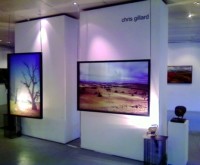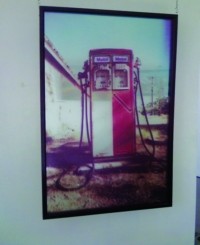 LOOKING for a unique way to display his work, Melbourne based Photographic Artist Chris Gillard has taken the concept of a simple photograph to another level. Using a colour separation method and glass, he has developed a production process that transforms a standard print into an intriguing semi-transparent 3D piece of art.
LOOKING for a unique way to display his work, Melbourne based Photographic Artist Chris Gillard has taken the concept of a simple photograph to another level. Using a colour separation method and glass, he has developed a production process that transforms a standard print into an intriguing semi-transparent 3D piece of art.
After years of pondering how he could create a point of difference in his photography, Gillard developed a colour layering method that supported his objective of turning photos into something more than just pictures.
He has used his colour layering process to create a collection of works titled Fragile Landscapes, which explores the idea of an Australian National Identity and its relationship to the natural environment. Series I (Soul), which consists of eight pieces that look to reflect our country’s heritage, was unveiled in December 2009 as part of the three week ‘Natural Selection’ exhibition at Green-Wood Gallery in South Melbourne.
Hung from the roof by chains, each piece measures 1.5m by 1m and is made up of four pieces of printed glass, aligned and assembled with a space between each layer. The overall effect is one of depth and an ever-changing landscape. Depending on lighting conditions and where you stand in proximity to the work, the pieces can take on very different qualities allowing viewers to interact with the imagery and form their own connection.
Gillard’s idea of the Australian landscape as a fragile, beautiful and valuable gift is reinforced through the use of glass as the principal material in the works. “Theoretically, I could have used any one of several clear materials, such as Perspex, and achieved a similar visual effect. However, the decision to use glass was a deliberate choice that serves to support the underlying artistic intent; reinforcing the fragility I have sought to portray.”
 Once he had chosen glass as the medium, Gillard approached Australian glass manufacturer Viridian with the hope of gaining the company’s support and assistance with glass supply. “It was extremely important for me to source the glass from an environmentally friendly manufacturer. During my research I came across Viridian and the fact that they are the only Australian manufacturer, coupled with the importance they place on sustainability and minimising any impact on the environment, convinced me that they would be the ideal supplier.”
Once he had chosen glass as the medium, Gillard approached Australian glass manufacturer Viridian with the hope of gaining the company’s support and assistance with glass supply. “It was extremely important for me to source the glass from an environmentally friendly manufacturer. During my research I came across Viridian and the fact that they are the only Australian manufacturer, coupled with the importance they place on sustainability and minimising any impact on the environment, convinced me that they would be the ideal supplier.”
Viridian’s Lachlan Austin says that after reading Gillard’s proposal, making the decision to become involved with the artist’s work was easy. “The message of ‘use glass in extraordinary ways’ has been a big part of Viridian’s identity since day one. Indeed we do see glass being used extraordinarily on a regular basis, whether it be a glass floor, energy efficient facade or part of an award winning home; however Gillard’s use of glass as the basis of a series of art is the first time we have seen glass be used so uniquely and so extensively outside its architectural applications.”
Seeing the potential of his image display method, Gillard sought to protect it with an international patent (pending). According to Gillard, there are several reasons he chose to protect his idea. “As with any artwork, much of its value lies within its unique qualities. The images I create have their own intrinsic value but still, I would not like to see my process appearing on every second street corner.”
“Another benefit in stopping the idea being appropriated by others is that it gives me more time to fully develop the concept. The reach of today’s digital world means that as soon as an idea is seen online it can be copied almost instantaneously by anyone anywhere in the world. I want time to fully develop the process I have created and this wouldn’t be possible if I hadn’t applied for a patent.”
Similarly, Gillard says the patent will help control the usage of the process. “It is clear to me that the concept has great potential for commercial applications. However, if the look I have invented was seen everywhere, the look becomes too common and again lowers the perceived value of the art, particularly in the eyes of a collector.”
Gillard’ reluctance to see his concept grace the facades of all high rise buildings and shopping complexes doesn’t mean that he doesn’t plan to explore its place in the architectural world. “I can definitely visualise the idea working on an architectural level. In fact, right now I am looking for an architect with vision and an appropriate project to collaborate on. So I welcome those types of enquires. Having said that, I want to keep my architectural art rare and therefore valuable; just like the natural environment.”
Each piece within Series I of the Fragile Landscapes collection is for sale and after only showing six of the eight (due to gallery space restrictions) Gillard is happy to report at least one sale at the time of publication, with strong interest in the pieces since the exhibition.
(Photography by Chris Gillard.)

